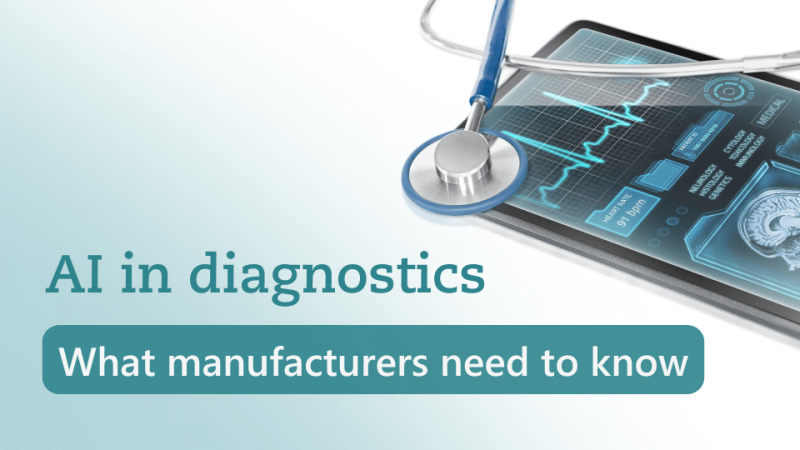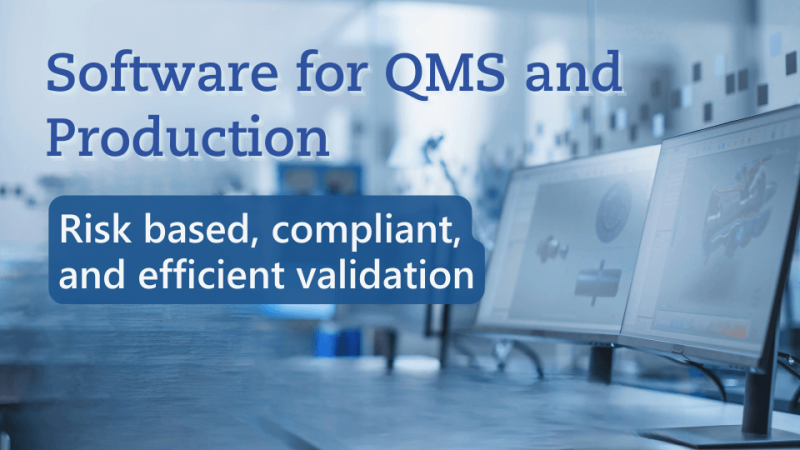Digital diagnostics: How AI and big data are revolutionizing the IVD field
01/07/2025
Do you have any questions about the article or would you like to find out more about our services? We look forward to hearing from you!Make a non-binding enquiry now
Digital diagnostics, especially those based on artificial intelligence (AI), offer enormous potential for faster, more accurate, and more personalized diagnoses. However, the path from concept to market-ready medical device is complex: manufacturers of in vitro diagnostic medical devices (IVDs) face significant regulatory challenges when seeking to place AI-based software solutions on the market under the In Vitro Diagnostic Medical Devices Regulation (EU) 2017/746 (IVDR). This article provides a hands-on overview of the regulatory requirements for digital diagnostics and shows how to avoid common pitfalls - so you can bring your digital solution to market successfully and in compliance with the law.
 Peter Hartung
Peter Hartung
Applications of AI in diagnostic test evaluation
There is no doubt: artificial intelligence is opening up new dimensions in diagnostics. Algorithms can analyze vast volumes of data within seconds, detect patterns, and make predictions. In many cases, they outperform human analyses—both in terms of speed and the volume of data they can process and consider. AI systems also handle a high degree of complexity with ease.In in vitro diagnostics, AI systems are primarily used for:- imaging procedures (e.g., of blood smears or histological sections),
- genomic analyses, and
- the integration of multiple laboratory parameters.
- PathAI Diagnostics by PathAI (USA)
AI-powered analysis of digital pathology slides for cancer diagnosis
(Automated tumor detection in breast and colorectal cancer) - SOPHiA DDM™ Platform by SOPHiA GENETICS (Switzerland, France, USA)
Cloud-based platform for molecular genetic diagnostics
(AI-assisted interpretation of large NGS datasets) - Freenome Platform by Freenome (USA)
Blood-based early detection of cancer
(Multiomics approach with AI for early-stage detection) - PD-L1 CDx – a collaboration between PathAI (USA) and Roche Diagnostics (Switzerland)
AI analysis of PD-L1 expression
(Standardized evaluation to support immunotherapy decisions) - DeepDx-Lab by DeepDx (South Korea)
Automated evaluation of hematological laboratory parameters
(AI-based early detection of hematologic anomalies)
- perform plausibility and cross-checks to verify that measurement results are logical and within expected ranges (e.g., detecting biologically impossible values),
- analyze machine and sensor data to identify technical issues in diagnostic devices early, such as identifying subtle pipetting errors through patterns in consumables or deviations in measurement times,
- systematically compare the performance of new reagent lots against previous ones to ensure consistency and stability of test results, and
- analyze quality assurance data to detect anomalies, trends, deviations, or missing documentation.
Regulatory requirements for AI-based IVD products
The regulatory evaluation of AI in IVD systems presents new challenges for companies. In the EU, such systems must meet the requirements of the IVDR in combination with the European AI Act (Regulation (EU) 2024/1689), if the system qualifies as high-risk AI - which applies to most of the examples mentioned earlier.Key considerations include:- traceability of algorithms,
- robustness of the training dataset,
- bias mitigation,
- systematic risk management,
- logging for result traceability,
- clear and appropriate user information, and
- suitable measures for human oversight.
- Form an interdisciplinary project team (management, legal, regulatory, IT, QM, R&D);
- conduct a gap analysis between the AI Act and the IVDR regarding quality management processes and technical documentation;
- review data sources for quality, representativeness, and bias, and perform a transparency analysis,
- train staff on AI Act–specific obligations and keep them up to date,
- incorporate data protection and cybersecurity requirements at an early stage,
- develop and expand a comprehensive post-market surveillance strategy,
- establish procedures for human oversight, and
- clarify AI conformity assessment procedures with the notified body early on—and change notified bodies in a timely manner if needed.
Digital biomarkers and companion diagnostics
Digital biomarkers in the IVD space are based on the computer-assisted acquisition, analysis, and interpretation of biological signals derived from laboratory parameters, molecular profiles, or highly sensitive assays. Using AI and machine learning, complex patterns from multiple data sources are translated into meaningful diagnostic or prognostic scores—often faster and more accurately than conventional methods. Their particular value lies in personalized medicine, where they support evidence-based decisions regarding diagnosis, therapy, and monitoring, while also helping to ease clinical workloads.Here are some product examples:- MeMed BV® by MeMed Diagnostics (Israel)
Differentiation between bacterial and viral infections through AI-based analysis of multiple laboratory parameters
(Combination of three biomarkers—TRAIL, IP-10, and CRP—from a blood test as input for an AI-supported decision model) - PancreaSure by IMMUNOVIA AB (Sweden)
Early detection of pancreatic cancer
(AI-based evaluation of an antibody multiplex profile as a digital biomarker) - Galleri multi-cancer early detection test by GRAIL, Inc. (USA)
Multi-cancer early detection via circulating DNA
(Digital biomarker derived from DNA combined with ML models) - NF-Light® – Neurofilament Light Chain Assay by Quanterix (USA)
Early detection of neurodegenerative diseases (e.g., MS, Alzheimer’s)
(Ultrasensitive digital biomarker on the Simoa® platform to measure NfL concentrations in serum, plasma, or cerebrospinal fluid samples)
- cobas® EGFR Mutation Test v2 by Roche Diagnostics (Switzerland)
Identification of EGFR mutations in non-small cell lung cancer (NSCLC) for treatment with EGFR inhibitors
(PCR-based test on DNA from plasma or tissue) - therascreen KRAS RCQ by Qiagen N.V. (Netherlands)
Detection of KRAS mutations in colorectal cancer
(Real-time PCR to select appropriate anti-EGFR therapies) - Oncomine Dx Target Test by Thermo Fisher Scientific Inc. (USA)
Multi-gene test for detecting relevant mutations in NSCLC
(Next-generation sequencing (NGS)-based CDx test with multiple FDA approvals) - MSI Analysis System by Promega GmbH
Microsatellite instability (MSI) in solid tumors to guide immune checkpoint inhibitor therapy
(PCR-based test to detect defective DNA mismatch repair (dMMR))
Impact on clinical decision-making processes
The integration of AI into IVD is fundamentally transforming clinical workflows. Physicians no longer receive static, individual test results, but data-driven, often predictive decision support tools. This can improve diagnostic certainty, accelerate treatment decisions, and enhance patient safety. At the same time, using such systems requires new competencies—both technical and ethical.Importantly, AI is not intended to replace medical decision-making but to support it meaningfully. Acceptance depends above all on transparent communication of the tools’ validity, clinical utility, and added value.How to prepare your AI-powered IVD for market approval
Many manufacturers of digital, AI-based IVDs—especially startups and research-driven organizations—struggle to bring their innovative products into regulatory alignment. Often, they lack established processes that meet IVDR requirements or do not yet have frameworks in place to address new standards for software, AI, and cybersecurity. Even established companies often need to update their existing development and quality management processes, particularly because many legacy products have not yet been approved under the IVDR.To systematically identify and close these regulatory gaps, we recommend a targeted gap analysis of existing processes, based on key standards such as:- IEC 62304 (Medical device software - Software lifecycle processes),
- IEC 82304-1 (Health software - Part 1: General requirements for product safety),
- IEC 81001-5-1 (Health software and health IT systems safety, effectiveness and security - Part 5-1: Security – Activities in the product life cycle
- ISO/IEC 42001 (Information technology – Artificial intelligence – Management system), and others.
Our blog posts are researched and created with the utmost care, but are only snapshots of the regulations, which are constantly changing. We do not guarantee that older content is still current or meaningful. If you are not sure whether the article you have read on this page still corresponds to the current state of regulation, please contact us: we will quickly place your topic in the current context.

Senior Expert Active Medical Devices & Software



